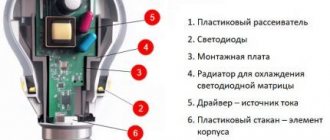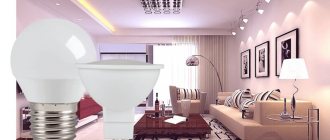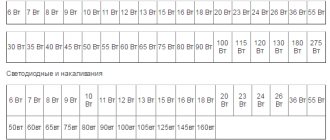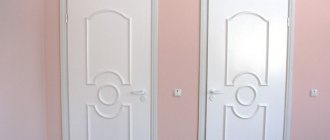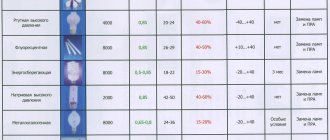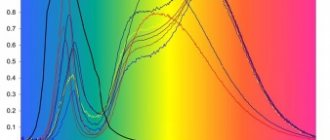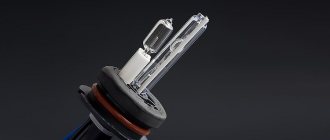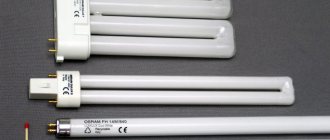Power
The power consumption of the lighting element is one of the main factors influencing the energy consumption of the device within 1 hour. Optimal indicators of 6-13 W correspond to a power of 50-100 W for incandescent lamps. The total energy consumption also takes into account the power of the drivers, which work together with the LEDs. They consume about 10-15% of the energy of the total power of the device.
Energy consumption of different types of light bulbs.
Base type
You need to know the dimensions of the base before purchasing so that the light bulb fits the socket in the lamp. Most often, LED lamps are produced with a threaded base E14 and E27. They are considered standard and are used in wall-ceiling lighting elements. There are also lamps with other base threads on sale:
- E40. Installed in lighting elements with high power. For example, in lamps for street lighting.
- G4, GU10. Bases in LED equipment that completely replace halogen lamps.
- GX53. Base carvings of this type are found in recessed lamps that are installed on the ceiling/wall covering.
Types of socles.
There are LED lighting elements on sale with a G13 base, which is used in tubular luminaires.
Series C (candle or conical)
C-shaped bulbs are also known as candelabra bulbs. They are defined as "a bulb consisting of a conical or nearly conical end portion which is connected to a neck by an approximately hemispherical portion" and has a convex base that leads to a round or pointed end. Some lamps have a curved end that creates a flickering flame effect.
The number is the diameter of the widest part of the lamp in eighths.
Application:
C Series lamps are used as accent lighting and decorative lighting. For example, on chandeliers, night lights and garlands.
LED lamp sizes
The size of LED lamps depends on their shape.
- Form A. This category includes household lighting equipment. The standard diameter of products is 60 mm. Lamps can have a diameter from 50 to 65 mm.
- Form B. Lamps with a more elongated body. Most often used to create decorative lighting. Standard size is 55-60 mm.
- Form C. Inserted into wall lamps and chandeliers. They have an elongated shape with a pointed end. The lamps use E14 base thread. Standard diameter is 37 mm.
- SA form. Devices with warm light that resembles candle lighting. Standard size is 35-37 mm.
- Shape G. Decorative LED lighting elements in a spherical shape. They have an E14 or E27 base. The sizes are different: lamps with a diameter of 30 mm for decorative lighting, with a diameter of 100 m for increased powerb. Standard diameter is 45 mm.
- Shape T. LED tubes are used for lighting commercial facilities. Standard diameter is 28 mm. Length - 60-120 mm.
Hull shapes.
In stores you can find LED lamps of different diameters: from 30 mm to 120 mm. The choice depends on the purpose and installation location.
LED lamps can be described as follows: the shape, diameter, length of the lamp and base can be named. For example, a candle-shaped lamp in the wind with a diameter of 37 mm and an E14 base.
What forms are there and are there general rules for designating them?
The shape of the lamp is the first characteristic that allows you to understand the purpose of the lamp, present it visually, and also determine a set of its other properties.
The picture to the right shows the most common lamp shapes. Of course, there are many more of them, but we will focus on those that are presented in the Kreonix assortment, as well as those that have LED analogues.
Shape A lamps are standard lamps for the home. A striking example is an incandescent lamp (pear lamp). The name of the form is the first letter of the English word Arbitrary, which translates as arbitrary. The number after the letter indicates the diameter of the lamp in millimeters. The standard lamp diameter is 60mm, that is, such a lamp will be designated as A60. Also, lamps can have diameters of 65, 55, 50 mm and others. Example of lamp A60 >>>
Shape B lamps are slightly elongated, the name comes from the word Bulged - bulging. The shape of the lamp resembles a torpedo. The lamp is used for decorative lighting.
C shape lamps are called candles. As with Shape A lamps, the number after the letter indicates the diameter. Kreonix offers candles with a diameter of 37 mm. Such lamps are used in crystal chandeliers and candelabra chandeliers. Most often the lamps have an E14 base. Example of a C37 lamp >>>
CA shaped lamps are a candle in the wind that are used in the same way as a candle for decorative lighting. Candle lamps usually have a low brightness, and the most popular models are those with a warm light, similar to the light of a real candle. Example of a CA37 lamp >>>
The CW shaped lamp is a twisted candle - another decorative option for a candle lamp.
E-shaped lamps are elongated ellipsoidal lamps. An example of such a lamp is a DRL gas-discharge mercury lamp.
G-shaped lamps , from English. Globe are called " globes ". These are decorative lamps with a regular spherical shape. Lamps of this shape can be found in E14 and E27 sockets. There are a huge number of sizes of these lamps: from the smallest with a diameter of 30 mm, to huge balls with a diameter of 100 mm. The most common sizes are 45 and 95 mm. Example of a G45 lamp >>>
| Dimensions PAR | Diameter, inch (US) | Diameter, inch | Diameter, mm | Size R |
| — | — | — | 39 | R39 |
| PAR16 | 16 | 2 | 50 | R50 |
| PAR20 | 20 | 2,5 | 63 | R63 |
| PAR30 | 30 | 3,75 | 95 | R95 |
| PAR36 | 36 | 4,5 | 114 | — |
| PAR38 | 38 | 4,75 | 120 | — |
PAR type lamps , from English. Parabolic aluminum reflector (parabolic aluminum reflector), have a reflective surface to focus light. For LED lamps, the designation PAR is used to describe the shape, since LED lamps do not have reflectors. The light from the LED is itself directional. The most widely used lamps are PAR20, PAR30 and PAR38. This shape is very similar to the R shape and, in some cases, PAR and R are interchangeable for LED lamps. Example of a PAR38 >>> lamp and an R >>> lamp
T (Tubular) lamps are tubes used primarily in administrative, retail and office premises as part of ceiling and wall lamps. Popular sizes are T5 and T8. Kreonix offers T8 lamps in 28mm diameters and 60mm, 120mm and 150mm lengths. Example of a T8 lamp >>>
Lamps of the JCDR and MR16 form are LED lamps that replaced halogen lamps MR16 with a radius of 50mm. The names JCDR and MR16 are used to distinguish lamps operating from 220 V and from 12 V. Such lamps are made in GU5.3 and GU10 sockets. Soffit lamps can have different light beam angles. The most common values are 30°, 90° and 120°. Example of a JCDR 220V lamp >>> and an MR16 12V lamp >>>
LED lamps of the JDR form are an analogue of halogen reflector lamps MR16, only with E14 and E27 sockets. JDR lamps are used in shop windows and for lighting stands. Example of a JDR lamp >>>
JC lamps are low-voltage LED analogues of halogen capsule lamps with a G4 (12V) socket. Such lamps are used to illuminate furniture and decor, in chandeliers and lamps. JC lamp example >>>
JCD lamps are LED analogues of halogen capsule lamps with a G9 base, operating on 220 V. Example of a JCD lamp >>>
Light flow
Luminous flux is the amount of energy given off by a lighting element. Knowing the parameter, you can quickly find a replacement for a burnt-out light bulb in lighting equipment. Luminous flux is measured in lumens. The second parameter is efficiency. It determines the ratio of the power of the luminous flux to the power of consumed electricity. These indicators indicate the efficiency of LED devices. For example, a standard incandescent lamp has a power of 20 W. Its luminous flux is equal to 250 lumens. The same light flux indicators are observed in LED bulbs with a power of 2-3 W.
Luminous flux indicators.
Product marking
When purchasing, you need to carefully study the labeling. This is important because all the main characteristics are indicated on it: light brightness, power, cost, service life.
The marking is usually placed on the box in which the desired device is located.
- The first thing that is always indicated on the packaging is power . The power of a device is a quantity that shows how much current it uses over a period of time (usually an hour). If the specified power is twenty watts (20 Watts), then twenty watts are spent per hour of work performed. The service life is often indicated on the packaging. It must be remembered that if the manufacturer indicated a service life of 30,000 hours, then this is a very approximate value. After all, the service life depends on many factors: the stability of the electric current, the environment in which it is located, the quality of the device itself.
- The packaging must have an energy efficiency class . Classes A+ and A++ show very high efficiency. The marking of a quality lamp contains the color temperature. Normal temperature and color temperature are completely different values. Regular temperature indicates the degree of heating. Color temperature, in turn, indicates the color that a given device emits. A low light temperature indicates yellow and warm colors of radiation, while a high light temperature indicates that it will be white, blue and cool colors.
- The brightness of the luminous flux is measured in lumens. A parameter such as flux indicates brightness. Normal brightness is 45-300 lumens. The labeling should also indicate the parameters of the power supply network to which the device is connected. Can withstand voltage up to 240 volts.
Scattering angle
The scattering angle of LED devices is the angle at which the light flux diverges from the light source. Indicators are measured in degrees. The values vary between 15-360 degrees. Conventional incandescent lamps have a standard beam angle of 360 degrees, LED devices have more advanced capabilities. Based on the scattering angle, they can be divided into three groups:
- Narrow angle (up to 60 degrees). Light elements with such indicators provide concentrated illumination of objects and are used for local illumination. For example, to illuminate a specific area in the house (mirrors, shelves, TVs).
- Wide angle (90-360 degrees). LED devices with such indicators create uniform lighting throughout the entire area of the room.
There is an intermediate option - lighting equipment with a dispersion angle of 60-90 degrees. These are standard lamps that can be used for both local and general lighting.
Scattering angle.
When purchasing lamps with an intermediate dispersion angle, it is better to choose models with a rotating option. It allows you to change the color direction. The standard value is 210 degrees. It is enough for full illumination of residential buildings. For commercial and design purposes, lamps with a scattering angle of 110-120 degrees are used to illuminate small details.
MR Series (multifaceted or quartz reflector)
An MR lamp is a “curved focusing reflective lamp that may have a multi-faceted internal surface that is typically dichroic or aluminum coated.” These lamps are used in many track lights and high-end kitchen fixtures, and also provide focused lighting for things that need attention, such as kitchen islands and dining tables. MR lamps were originally developed for projectors, but are now more commonly used in residential and retail lighting.
Colorful temperature
Color temperature is an indicator that indicates the shade of the emitted light flux. Conventionally, all lamps are divided into three types:
- With warm color temperature.
- With neutral color rendering indicators.
- With cold light.
Types of color rendering.
When choosing lighting fixtures, take into account the place in which they will be used. If this is a bedroom, it is better to give preference to warm or white lighting (up to 3000 K). In the kitchen and bathroom it is better to use lamps with neutral lighting (3500 K). If commercial objects are illuminated, then it is advisable to choose cool lighting. Equipment that creates the effect of daylight (more than 5300 K) is not used in residential spaces, only for specific work. Cold light lamps are also used as elements for emergency lighting. Comparison table:
| Parameters of LED lamps, type of lighting, created atmosphere in the room | |||||
| Temperature | Warm light (2700 K) | White lighting (3000K) | Neutral lighting (3500K) | Cold light (4100 K) | Daylight (6000 K) |
| Atmosphere | Warm and cozy atmosphere | Brighter light that creates a pleasant atmosphere with good visibility | Pleasant atmosphere with excellent visibility | Bright and clean atmosphere | Emphasizing colors and too bright atmosphere |
| Where is it used? | Residential premises, cafes and restaurants, boutiques | Shops, offices, libraries | Office premises, exhibition halls, supermarkets, shops | Offices, hospitals and hospitals, large supermarkets, shopping centers, classrooms in schools | Galleries, exhibitions, jewelry outlets, medical offices that are used for examinations |
Series G (Globe)
G Series lamps are "substantially spherical" lamps. These lamps work well in fixtures where the spherical shape of the lamp can visually increase the spread of the beam. These lamps are typically used for decorative purposes such as vanities and chandeliers. These are decorative light bulbs that illuminate many bathroom items.
Application:
G Series lamps can be used in many areas of the home, such as wall sconces, kitchen lights, chandeliers or beauty fixtures.
Life time
When choosing LED lamps, you should also take into account their service life, which manufacturers indicate on the packaging. However, these indicators are very relative. Even if the manufacturer indicates on the box a work life of 30 thousand hours, the LED lamp may fail much earlier. The overall service life depends on other parts of the equipment. This indicator is also affected by the quality of assembly of the lamp and the soldering of radio elements. Since LED elements have a long lifespan, no manufacturer can test the operating time. Therefore, all signs on packages can be considered conditional.
Service life of different types of light bulbs.
Adjustable LED lamps
LED devices allow you to adjust the brightness of the lighting. This happens with the help of a control device - a dimmer. The regulator helps to obtain the most suitable light that will not strain your eyesight. The dimmer works by generating pulses. Their frequency affects the brightness of the lighting. Not all LED systems can be adjusted using a dimmer. Its functions can be performed by a driver that is built into the lamps. In this case, the functionality will be somewhat limited.
If the buyer needs dimmable equipment, it is worth carefully studying the packaging of the products. All manufacturers write on the boxes about the possibility of adjusting lighting.
Advantages and disadvantages of LED lamps
The advantages of LED lamps include:
- Lifetime. Light sources operate for 50,000 to 100,000 hours without interruption.
- Economical energy consumption. LEDs are classified as lighting sources with an efficiency 10 times higher than their analogues.
- Heat resistance. LED lamps are resistant to atmospheric changes and do not deteriorate due to sudden changes in temperature.
- Environmentally friendly. Manufactured from safe materials that are not harmful to health.
Disadvantages of LED lamps:
- Price. Lighting elements are more expensive than their main analogues.
- Size. High power lamps have large dimensions. This is not always convenient for rooms with a small area.
- LED driver. For stable operation of the LED system, a special power supply is required, which also has a high cost.
Another disadvantage is the difficulty in replacing diodes if they burn out. Sometimes this is impossible to do.
The most obvious advantage is energy savings.
The difference between LED lamps and other light sources is the transformation of light into any shade.
Technical characteristics of LED lamps
Before purchasing an LED lamp, you need to familiarize yourself with its main parameters - power, base type, spectrum of emitted light, and others.
✍ Power of LED lamps
On the packaging of the LED lamp, manufacturers indicate the power consumption from the electrical network. The power of incandescent lamps, which are identical in brightness, is also often indicated.
There is a misconception that the equivalent of a 100-watt incandescent lamp is a 10-watt LED. In fact, its brightness is reduced by about 20% due to the frosted bulb. An additional 1 W is spent on heating the “driver” (voltage converter). As a result, only 7 useful Watts will remain from the declared power, providing a luminous flux of 700-800 Lumens.
In order not to make a mistake with your choice, you should first familiarize yourself with the correspondence table, which indicates the luminous flux and power.
| Incandescent (W) | LED lamp (W) | Luminous Flux (Lm) |
| 25 | 3 | 250 |
| 40 | 5 | 400 |
| 60 | 8 | 650 |
| 100 | 14 | 1300 |
| 150 | 22 | 2100 |
LED lamps with maximum power are equipped with special bulbs that have a matte surface and serve to protect the eyes from too bright light.
✍ LED light
LED lamps are produced with different color temperatures, which characterize the tone of the glow. This parameter is measured in Kelvin and is indicated by the manufacturer on the packaging with the lamp. The light changes as the temperature rises - from yellow to white-blue.
| Temperature indicator | Color | Characteristics |
| 2 700 K | Warm with a yellow tint | Almost identical to the emission color of conventional incandescent lamps |
| 3,000 K | White warm | Pleasant and comfortable light, considered optimal for residential premises |
| 4,000 K | White cold | As close to daylight as possible. Most preferable for use in offices, as well as commercial and industrial premises |
Some manufacturers produce LED lamps with adjustable color temperatures. When changing the mode, the spectrum of the glow changes.
✍ LED lamp sockets
The socket is the part of the lamp that is used to connect to the socket. Thanks to this, the contacts fit securely and tightly, providing power to the lighting fixture.
LED lamps are produced with both standard and specific types of sockets. There are two large groups into which they are divided - threaded and contact.
Threaded sockets typical for LED lamps include :
- E27 - intended for all types of standard lamps with a luminous flux of over 1200 Lumens. Such lamps function well at an electrical voltage of 220 W, as well as in alternating current conditions.
- E14 , also known as "minion" and having miniature dimensions. Often such light bulbs are made in the form of a ball, candle, mushroom or other non-standard shapes.
- E10 - used to illuminate the interior of refrigerators and freezers.
- E42 - this type of base is intended for LED lamps that are used for street lighting.
Contact sockets are also called "pin" sockets due to their inherent design. They are equipped with special leads, which are located at the edges of the lamp and are made in the form of pins.
This category includes the following types of bases:
- Equipped with a connector with two pins, as well as a convenient swivel mount, it is most often used when arranging ceiling lighting, installed in LED lamps that have a standard size of MR16 .
- GU5/3 is the base most often used for decorative lighting and is compatible with lamps that operate on reflector LEDs.
- G13 - intended for office and other types of premises. This type of base is typical for T-8 and T-10 lamps, which are manufactured in a tube-shaped form. They are used in ceiling panels installed in offices to provide directional lighting for work areas.
Another category of socles is the pin bayonet. Connection to the cartridge is ensured using special pins, which are located on the base body. On the sides there are two symmetrical pins with a round cross-section. They are first secured in special slots on the cartridge, and then, to ensure a more reliable fixation, they are turned a quarter turn.
Cars use lamps with BA sockets. This is a type of pin base, which has asymmetrical contacts on the sides. Thanks to the non-standard design, the lamp inserted into the socket ensures correct focusing of the light flux of the headlights.
Unlike other types of lamps, LED lamps can be equipped with bases that have non-standard shapes:
- With recessed contact . This parameter is determined by the presence of the letter “R” on the marking. Such products are used in light and small-sized LED light bulbs.
- Soffit "S" - placed on one or both sides of lamps with a tubular design. The scope of application of such LED lamps is car showrooms, bathrooms, as well as mirror lighting.
- Telephone “T” - typical for miniature light bulbs, used as backlight, in remote controls, as well as in car dashboards.
- Fixing "P" . This type of plinth is similar in design features to a soffit plinth, with the exception of the presence of an additional dissipative platform. A special prefabricated lens ensures the direction of the required light flux. Designed for flashlights and spotlights, as well as film projectors.
✍ Dimmer compatible
A dimmer is an electronic device that changes the power of electricity. Its main task is to adjust the brightness level of the light that the lamps emit.
Unlike halogen and incandescent lamps, LED lamps are not always compatible with dimmers. Therefore, when purchasing this product, you need to pay attention to the icon on the packaging that says Dimmable, which means “dimmable lamp.”
Compared to standard LED, dimmable options have a higher cost.
In some situations, even a regular LED lamp can be dimmed. This is more of a disadvantage than an advantage. The reason is that the design is not entirely correct, in which the installed driver does not provide protection against overloads and surges in the electrical network.
✍ Operating voltage and heat dissipation
LED lighting requires a voltage of 12 or 24 volts to operate. In addition, the converter provides power from a 220 W network. The converter can be either built into the lamp body or a separate device.
People who are unfamiliar with how LED lamps work are wondering whether they are exposed to heat or not. On one side the LED emits light, and on the other, the opposite side, heat flow is directed. The probability of heating is directly related to the power of the lamp itself. Products with minimal power contain a built-in cooling radiator inside their case. More powerful LED spotlights are equipped with radiators with a ribbed structure made of aluminum.
